ENTERING THE IRISH LANDSCAPE
By Warrick Wynne
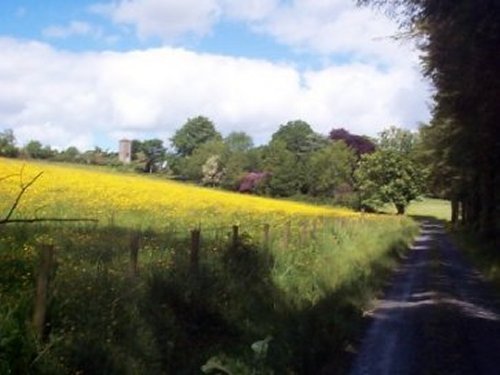
[Above] Road to the Tyrone Guthrie Centre, County Monaghan, Ireland (Photo by Warrick Wynne, 2000)
There's a photograph by Hannah Collins in the New Tate Gallery in London called 'The Course of Time' of the neglected Jewish graves in Warsaw, Poland. It's totally arresting, spanning the whole wall, blown up large as life. You can see the tangled creeper dangling over the broken stones, and you can read the names of the Jewish dead and see how the stones are falling, or tilting, and how terrible is the crime of neglect and the slow erasure of the past.
The startling thing about the photograph for me, and its mystery, is that you feel as if you have just stumbled upon this scene. You've been walking along a gravel track, the fine compressed stone is dulled by the leaves over the track and the soft dampness that seems everywhere. The forest (that European word works here) is close around you and you wonder where this deserted-looking path leads; it's disturbing somehow, the lack of light here, wasn't it sunny before? and the way you have found yourself alone. Suddenly you find yourself at a clearing of some kind, lighter, but surrounded by the chopped off axe-ends of the forest. You almost blink as you adjust your eyes, look around, at the twisted and falling gravestones. The path goes on beyond somewhere, but you stand still at this place, this moment when the landscape has been caught. That the photograph is black and white, and patently not reality but document, accentuates this dual tension; the illusion of reality or 'natural-ness' and the consciousness of the artist.
It's a photograph I thought about a lot as I was thinking about how to capture the Irish landscape on my trusty digital camera and in this article. How do you get to that moment of 'arrival' in landscape and how you can you know what you're actually seeing? In his book, 'Landscape and Memory', one of Simon Schama's central points is that, 'Even the landscapes that we suppose to be most free of our culture may turn out, on closer inspection, to be its product' and that we read landscape through the historical and cultural memory we bring to it. David Matless goes further, arguing that it's better to see the word 'landscape' as a verb, an active construction or a 'process by which identities are formed'. What memories and expectations did I bring with me; what was I looking to find? And how could I find it?
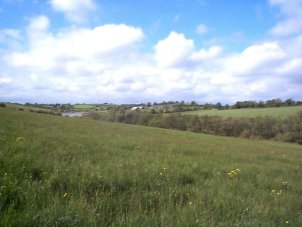 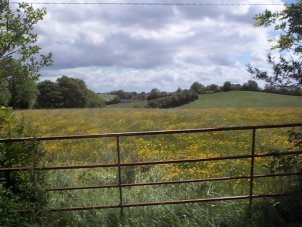
[Above Left] Folds of fields, County Monaghan, Ireland (Photo by Warrick Wynne, 2000) [Above Right] Gateway to Landscape, County Monaghan, Ireland (Photo by Warrick Wynne, 2000)
In Ireland I felt often that I was walking alongside landscape but couldn't enter it. Is the landscape over that fence, or beyond that gate? If I was in the middle of that field, would I be in the landscape? One of the problems is that of perspective; who is looking, and in what direction? Does landscape exist without an observer to frame it? Or does it come into existence when captured in a photograph or in a poem? Perhaps the real role of the landscape artist or poet is to help the viewer/reader into the truth of the place; to unlock the entrance. As the American photographer Robert Adams writes, 'what we hope for from the artist is help in discovering the significance of a place'. So 'landscape' in this sense is not so much 'edited reality' but a kind of distillation of the larger into some essence.
In her guide about landscape painting, Erika Langmuir reminds us of the contrivance that is at the heart of landscape painting: 'Easel pictures in particular are conventional objects, with a surface, size, shape and borders that any arrangement of form and colours must take into account. Even leaving aside the cultural conditioning that enables one to seek aesthetic scenery, the very notion of excerpting a motif from boundless three-dimensional reality involves knowing there are such things as landscape paintings ... Even the most spontaneous and original plein-air painter will therefore, consciously or not, tend to set up an easel where reality fits a preconceived idea of a picture.' (75) So, do we accept that any choice to 'frame' a landscape through a camera lens or an easel is just that, a choice made for any number of reasons including that this 'scene' framed is agreeable or pleasing, a kind of lyrical and idealised visual souvenir with the pig farm edited out in Photoshop or the darkroom? Or perhaps there is a 'Science of Scenery' as the English geographer Vaughan Cornish argued in the 1930s: 'The laws of scenery may be compared with those of music. They are the laws of harmony.'
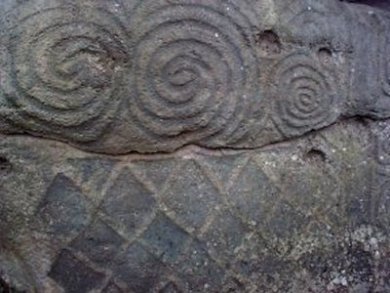
|
Even the concept of 'wilderness', like its descendant, landscape, poses problems for those who wish to portray it. How do you photograph it? You must arrive somehow, unless you're dropped in by helicopter. I remember the calendars the Wilderness Society put out a few years ago, beautiful close-up photographs of water running over rock or flowers and stones immaculate on a bed of moss. It was as if you were having a sneak peep at undisturbed 'nature', nothing had been touched, nothing out of place, but I had a feeling too that it had all been arranged for me like this, that the whole picture-perfect miniature wilderness could be housed in a shoe-box. |
[Above] Neolithic engravings, Newgrange passage tomb, Ireland (Photo by Warrick Wynne, 2000)
Is it possible then to 'know' the landscape, or are you always in interpretative mode? Thoreau felt he had to immerse himself in the 'wilderness' in an attempt to understand just that part where he lived. Such a focused exploration of a the specific region led to his famous ennobling of the local in 'I have travelled a good deal in Concord' and to some of my favourite lines from Thoreau: 'I frequently tramped eight or ten miles through the deepest snow to keep an appointment with a beech tree, or a yellow birch, or an old acquaintance among the pines'.
Thoreau, like other 'regional' writers such as Thomas Hardy, was aware of the universal within the local but it is dependant upon an intimacy with the landscape that is impossible to attain in a short time. Perhaps that kind of 'local knowledge' is still seen, in the sales rep who knows the secret flows to avoid traffic jams or Citylink road tolls, or the surfer who knows just what place on the coast will have the best waves given today's particular combination of wind, tide and swell size and direction. Gilbert White, in what is often regarded as the first local natural history, 'The Natural History of Selborne' (1751), took such a 'scientific' approach in the meticulous accumulation of detail. Repeated observation leads to pattern leads to prediction leads to knowledge, something like that.
The other difficulty I had in coming to understand the nature of Irish landscape was the predominance of the human. The land has been imposed upon for thousands of years in such a way that it is rare to talk about 'wilderness', and even the notion of 'natural-ness' might be confined largely to scattered areas of the coastline. It is hard to walk far in the countryside without encountering the human or the wreckage of the human. Were these lands ever not shaped by the fences and hedge-rows? Is it possible now to find or imagine how this place would have looked without the grid paper of land ownership and delineation? Probably not.
The stark fact of the nineteenth century famine, when Ireland lost virtually half its population to starvation and emigration, is evident everywhere in the abandoned cottages that dot the countryside and which constituted a central part of the landscape for me. There are cottages still, they say, that you can walk into, where everything is just 'as it was', as if the occupants just walked outside for a moment and never returned. In a land parcelled off in the human notion of the 'field', the regularity of such stone-grey wreckage as the abandoned cottage emphasises the 'pastness' of this landscape, the feeling of a place in permanent decline or at least beyond the idea of growth.
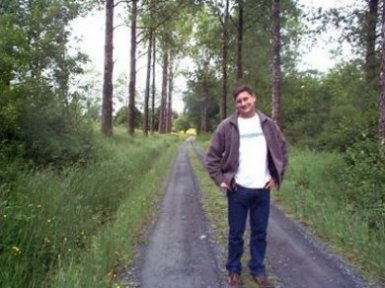
|
As the curator in the Galway Museum tells me seriously, 'Galway has never recovered from Cromwell in 1652'. The layers of the past combine so that it's difficult to see the landscape in terms that don't include the human. You can stumble across the rings of stone in a farmer's field. The earthen works of the siege machinery can be walked to. At Annakhmakerrig in County Monaghan where I was staying, two forts are marked on the small map of the property. They are probably from Neolithic times and there are rows of ancient trenches above the lake that are a fort circle or mere drainage channels, depending on who you talk to. |
[Above] Australian Writer Warrick Wynne, County Monaghan, Ireland (Photo by Jerry McGrath, 2000)
Each period has left its debris or its physical imprint and The Department of the Environment even puts out a booklet for farmers explaining to them how to help conserve landscape features such as historic monuments which they might find on their property.
The Neolithic Period left large stone tombs (megalithic tombs), passage tombs and wedge tombs. Smaller stone structures also survive from prehistoric times including groups of standing stones set in circles or straight rows, single standing stones, cairns of stones built to cover burials or simple field clearance cairns.
I squeezed in the narrow passageway at Newgrange, a passage tomb over 5000 years old with a mound covering over an acre, constructed of over 200,000,000 tons of stone and earth and I walked across a field at Carrowmore Megalithic Cemetery on the west coast that was dotted with over fifty stone circles constructed a thousand years earlier than Newgrange and perhaps two thousand years before the pyramids.
Later, earthen monuments such as burial grounds called barrows date from the Bronze Age (2000-500 BC) as do the ritual assembly sites or henges. From Early Christian times it is possible to find rath or ringfort or fort. As Christian outposts became more established (500-1200 AD) church settlement sites, usually distinguished by an enclosed earth bank and ditch up to one hundred metres in diameter became common. As the settlements went out of use, the church and the graveyard often continued, becoming the remnant of a once larger site. Monastic sites sometimes centred around a high Celtic cross, some of which endure today but many of which have been placed in museums to protect them from the elements. I saw one, still in its original place, in Clones. In the centre of the town stood a tall stone cross, and it seemed that the town had grown around it.
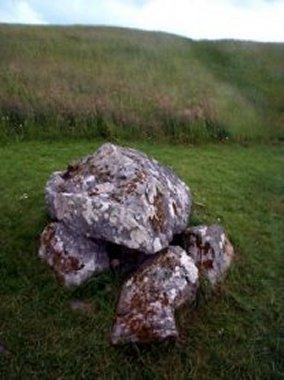 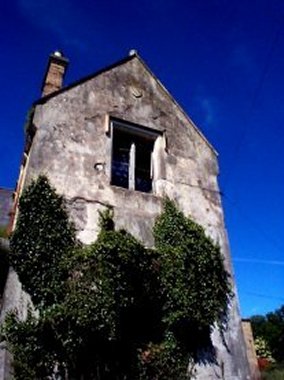
[Above Left] Rocks at Carrowmore Megalithic Cemtery, County Sligo, Ireland (Photo by Warrick Wynne, 2000) [Above Right] Abandoned railway station, Newbliss, County Monaghan, Ireland (Photo by Warrick Wynne, 2000)
And then more junk: In the Middle Ages (1200-1600 AD) early earthen castles or mounds were replaced with smaller family castles called tower-houses. From about 1600 the Plantation Period bequeathed some large ruins of the settlers' houses from Scotland and England. Later, the Industrial Revolution from around 1750 left features such as lime-kilns, canals, the lines of old roads and railways and mills of many kinds. The famine in 1846 left deserted farmhouses. Even the trees themselves, virtually all now part of an elaborate human re-planting, signify human occupations: the hawthorn tree buried over the body of the murderer; the yew tree of the pre-Christian sites where the churches would often be built later.
So that, while Australia is a landscape shaped by successive waves of immigration, Ireland's landscape is a landscape of emigration and emptiness. These human features aren't 'on' the landscape, they create it. That doesn't mean the pre-human features aren't there. County Monaghan, for example, is drumlin country; small rolling hills created by the southernmost extent of the last ice age. It's a landscape of hidden places, miles of identical-looking hills, often centred around small lakes or bogs. They say that the local Tesco's is sinking into the swamp. It also created a landscape perfect for a furtive kind of anonymity; ideal for the political border-space that it occupies. It also makes driving an interesting experience and walking anywhere an up and down affair. What it does mean though is that while the mythic Australian landscape might be some 'untouched' place, to be protected and preserved, the Irish landscape is trampled with the shoes of the past.
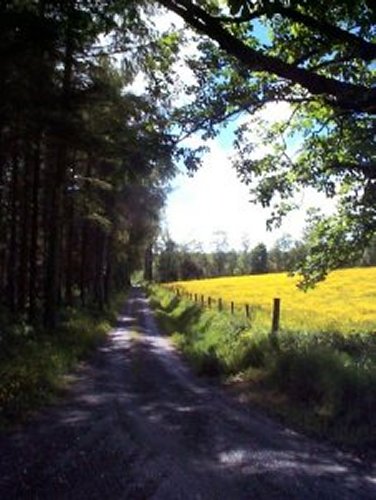
|
Walking down to the lake below the house one day I looked out across the blue-grey water and imagined the walk around it I had done the day before. It takes about forty minutes but the rain had made it too wet today. I remembered walking through the edge of the pine plantation they'd planted on the hill; was this walking through an Irish landscape? The pines were imports, planted to grow fast for cheap timber; you see it in Victoria all the time; up around the Ovens Valley the green of the pine forest looks cheap and artificial next to the gum trees. Looking across at the pine forest was like looking at an Alpine scene almost; the cold lake, the pine trees in the distance.
I was about to walk back up when I saw, washed up at my feet, the slender white feather of a swan. It's hard for someone who has read poetry to find a swan feather by a lake in Ireland and not think of Yeat's lines from 'The Wild Swans at Coole': 'Upon the brimming lake are nine and fifty swans'. |
[Above] Country Lane, County Monaghan, Ireland (Photo by Warrick Wynne, 2000)
The memory of the poem, the wet feather and the sight of the swans themselves, luminous against the dark trees in the distance, suddenly made this landscape seem very different indeed; it was the most Irish place imaginable and any resemblance to Bavaria or the Swiss Alps had suddenly vanished in a wistful nostalgia for the Ireland of the Celtic twilight. So, in that moment at the edge of the lake, that's how I saw the landscape.
Sources:
Robert Adams, Beauty in Photography, Aperture, 1981
Claire Foley, Understanding Historic Monuments on the Farm, Department of the Environment for Northern Ireland
Erika Langmuir, Landscape, National Gallery 1997
David Mattless, Landscape and Englishness, Reaktion Books, 1998
Simon Schama, Landscape and Memory, Harper-Collins, 1996
Warrick Wynne was in Ireland on an Australia Council overseas residency working on his poetry.
About the Writer Warrick Wynne
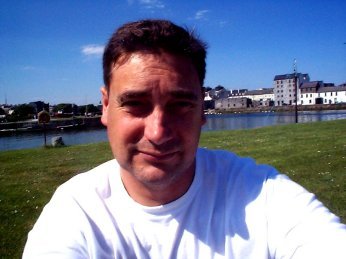
|
Warrick Wynne has been writing poetry for about fifteen years and has been published in a wide variety of literary journals both in Australia and overseas. He won the Red Earth Poetry Prize in 1992 and has been a runner up in several other poetry awards including the Mattara Poetry Prize administered by the University of Newcastle. Warrick is a member of the Fellowship of Victorian Writers (FAW) and the Poets' Union. Warrick teaches English and Literature at Toorak College, a K-12 school for girls on the Mornington Peninsula, forty kilometres south of Melbourne in Australia. He has written texts for students completing their final year of English. |
[Above] Photo of Warrick Wynne by Warrick Wynne, 2000.
I Next I
Back I
Exit I
Thylazine No.2 (September, 2000) |



